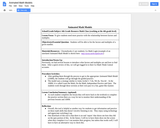
To give students need more practice with the relationship between factors and multiples.
- Subject:
- Algebra
- Mathematics
- Material Type:
- Lesson
- Provider:
- Michigan Virtual
- Author:
- Laura Harkema
- Date Added:
- 05/19/2017

To give students need more practice with the relationship between factors and multiples.
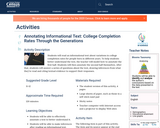
Students will read an informational text about variations in college completion rates for people born in different years. To help students better understand the text, the teacher will model how to annotate the first half. Students will then annotate the second half themselves. After that, students will answer a series of questions about the text, drawing inferences from what they’ve read and citing textual evidence to support their responses.
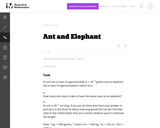
In this problem students are comparing a very small quantity with a very large quantity using the metric system. The metric system is especially convenient when comparing measurements using scientific notations since different units within the system are related by powers of ten.

Students will examine a table of 1850 Census data on employment to understand the professions of free men across the United States at the time, calculating the percentages working in different industries. Students will also compare and contrast economies in the North and South during the Antebellum Period.
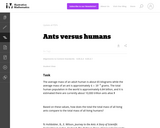
This task requires students to work with very large and small values expressed both in scientific notation and in decimal notation (standard form). In addition, students need to convert units of mass.

This short video and interactive assessment activity is designed to teach fifth graders about total distance without unit conversion (metric units).

This short video and interactive assessment activity is designed to teach fourth graders about calculating distance in meters.
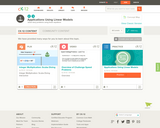
This short video and interactive assessment activity is designed to teach fifth graders about total length - challenge problems.
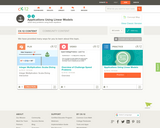
This short video and interactive assessment activity is designed to teach fourth graders about time and rate problems.

This short video and interactive assessment activity is designed to teach fourth graders about determining task length.
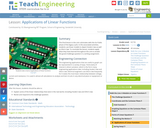
This final lesson in the unit culminates with the Go Public phase of the legacy cycle. In the associated activities, students use linear models to depict Hooke's law as well as Ohm's law. To conclude the lesson, students apply they have learned throughout the unit to answer the grand challenge question in a writing assignment.
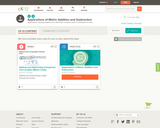
This short video and interactive assessment activity is designed to teach fifth graders about adding and subtracting lengths (metric units).
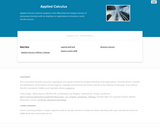
Applied Calculus instructs students in the differential and integral calculus of elementary functions with an emphasis on applications to business, social and life science. Different from a traditional calculus course for engineering, science and math majors, this course does not use trigonometry, nor does it focus on mathematical proofs as an instructional method.
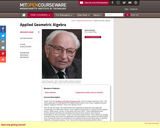
Laszlo Tisza was Professor of Physics Emeritus at MIT, where he began teaching in 1941. This online publication is a reproduction the original lecture notes for the course "Applied Geometric Algebra" taught by Professor Tisza in the Spring of 1976. Over the last 100 years, the mathematical tools employed by physicists have expanded considerably, from differential calculus, vector algebra and geometry, to advanced linear algebra, tensors, Hilbert space, spinors, Group theory and many others. These sophisticated tools provide powerful machinery for describing the physical world, however, their physical interpretation is often not intuitive. These course notes represent Prof. Tisza's attempt at bringing conceptual clarity and unity to the application and interpretation of these advanced mathematical tools. In particular, there is an emphasis on the unifying role that Group theory plays in classical, relativistic, and quantum physics. Prof. Tisza revisits many elementary problems with an advanced treatment in order to help develop the geometrical intuition for the algebraic machinery that may carry over to more advanced problems. The lecture notes came to MIT OpenCourseWare by way of Samuel Gasster, '77 (Course 18), who had taken the course and kept a copy of the lecture notes for his own reference. He dedicated dozens of hours of his own time to convert the typewritten notes into LaTeX files and then publication-ready PDFs. You can read about his motivation for wanting to see these notes published in his Preface below. Professor Tisza kindly gave his permission to make these notes available on MIT OpenCourseWare.

This lesson unit is intended to help you assess how well students are able to use geometric properties to solve problems. In particular, it will support you in identifying and helping students who have the following difficulties: Solving problems relating to using the measures of the interior angles of polygons; and solving problems relating to using the measures of the exterior angles of polygons.
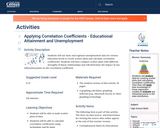
Students will use state and regional unemployment data for various education levels to create scatter plots and calculate correlation coefficients. Students will then compare scatter plots with different strengths of linear relationships and will determine the impact of any influential points on the correlation coefficient.
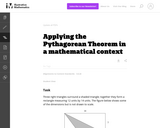
This task requires students to apply the Pythagorean Theorem.
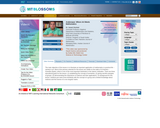
The main objective of this lesson is to illustrate an important application of mathematics in practical life -- namely in art. Most of the pictures selected for this lesson are visible on the walls of Al-Hambra – Granada (Spain), which is one of the most important landmarks in the Islamic civilization. There are three educational goals for this lesson: (1) establishing the concept of isometries; (2) giving real-life examples of groups; (3) demonstrating the importance of matrices and their applications. As background for this lesson, students just need some familiarity with the concept of a group and a limited knowledge about matrices and the inverse of a non-singular matrix.
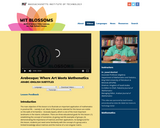
The main objective of this lesson is to illustrate an important application of mathematics in practical life -- namely in art. Most of the pictures selected for this lesson are visible on the walls of Al-Hambra – Granada (Spain), which is one of the most important landmarks in the Islamic civilization. There are three educational goals for this lesson: (1) establishing the concept of isometries; (2) giving real-life examples of groups; (3) demonstrating the importance of matrices and their applications. As background for this lesson, students just need some familiarity with the concept of a group and a limited knowledge about matrices and the inverse of a non-singular matrix.
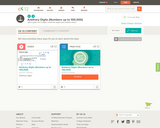
This short video and interactive assessment activity is designed to teach third graders about creating largest and smallest numbers given digits.